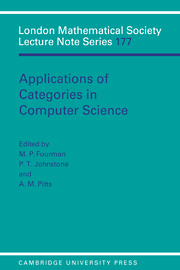 Applications of Categories in Computer Science
Applications of Categories in Computer Science Published online by Cambridge University Press: 24 September 2009
Abstract
Domain theoretic understanding of databases as elements of powerdomains is modified to allow multisets of records instead of sets. This is related to geometric theories and classifying toposes, and it is shown that algebraic base domains lead to algebraic categories of models in two cases analogous to the lower (Hoare) powerdomain and Gunter's mixed powerdomain.
Terminology
Throughout this paper, “domain” means algebraic poset – not necessarily with bottom, nor second countable. The information system theoretic account of algebraic posets fits very neatly with powerdomain constructions. Following Vickers [90], it may be that essentially the same methods work for continuous posets; but we defer treating those until we have a better understanding of the necessary generalizations to topos theory.
More concretely, a domain is a preorder (information system) (D, ⊆) of tokens, and associated with it are an algebraic poset pt D of points (ideals of D; one would normally think of pt D as the domain), and a frame ΩD of opens (upper closed subsets of D; ΩD is isomorphic to the Scott topology on pt D).
“Topos” always means “Grothendieck topos”, and not “elementary topos” morphisms between toposes are understood to be geometric morphisms.
S, italicized, denotes the category of sets.
We shall follow, usually without comment, the notation of Vickers [89], which can be taken as our standard reference for the topological and localic notions used here.
To save this book to your Kindle, first ensure [email protected] is added to your Approved Personal Document E-mail List under your Personal Document Settings on the Manage Your Content and Devices page of your Amazon account. Then enter the ‘name’ part of your Kindle email address below. Find out more about saving to your Kindle.
Note you can select to save to either the @free.kindle.com or @kindle.com variations. ‘@free.kindle.com’ emails are free but can only be saved to your device when it is connected to wi-fi. ‘@kindle.com’ emails can be delivered even when you are not connected to wi-fi, but note that service fees apply.
Find out more about the Kindle Personal Document Service.
To save content items to your account, please confirm that you agree to abide by our usage policies. If this is the first time you use this feature, you will be asked to authorise Cambridge Core to connect with your account. Find out more about saving content to Dropbox.
To save content items to your account, please confirm that you agree to abide by our usage policies. If this is the first time you use this feature, you will be asked to authorise Cambridge Core to connect with your account. Find out more about saving content to Google Drive.